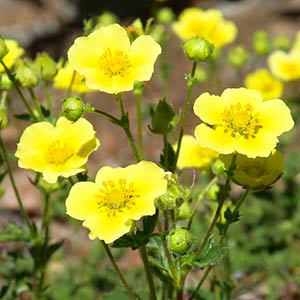Drymocallis pseudorupestris
Drymocallis rhomboidea
cliff drymocallis, cliff woodbeauty, false rock loving cinquefoil, Rocky Mountain sticky cinquefoil
common cinquefoil, globose drymocallis, rhomboid sticky cinquefoil, Siskiyou drymocallis, Siskiyou or globose drymocallis or wood beauty
elongate.
short.
openly tufted to loosely spaced, (0.3–)0.6–4 dm;
base 1–3 mm diam., ± densely septate-glandular.
± tufted, 1.7–4.7 dm;
base 1–3 mm diam., usually not septate-glandular.
glabrate or sparsely to ± densely hairy;
basal (2–)3–16 cm, leaflet pairs (2–)3–4(–5);
terminal leaflet broadly obovate-cuneate to flabellate, 0.2–3(–4) × 0.5–3 cm, teeth single or double, 2–15 per side, apex usually rounded to truncate, sometimes obtuse;
cauline 0–2, reduced, leaflet pairs 2–3.
moderately to densely hairy;
basal 5–12 cm, leaflet pairs 3;
terminal leaflet obovate-elliptic, 1–2.5(–3) × 1–2(–2.5) cm, teeth single or double, 6–10 per side, apex obtuse to rounded;
cauline 0–2, developed or reduced, leaflet pairs 2–3.
2–40-flowered, not or ± leafy, open, 1/6–3/4(–4/5) of stem, ± wide, branch angles (10–)20–40(–50)°.
5–35-flowered, ± leafy, usually ± open, 1/3–2/3 of stem, wide, branch angles 15–60°.
3–20 (proximal to 40) mm, not or sparsely to moderately short-hairy, predominantly septate-glandular.
1–5 (proximal to 15) mm, predominantly short-hairy, usually not or sparsely, sometimes moderately, septate-glandular.
opening widely;
epicalyx bractlets linear to elliptic, 2–6 × 1–2 mm;
sepals spreading, 4–7(–9) mm, apex acute to obtuse, apiculate;
petals overlapping or not, spreading, cream-white to pale yellow (red-tinged in var. crumiana), narrowly to broadly obovate, 4–12 × 3–11 mm, longer than sepals;
filaments 1–4 mm, anthers 0.7–1.2 mm;
styles thickened, 1–1.5 mm.
opening narrowly;
epicalyx bractlets linear-oblanceolate, 2–3.5 × 1 mm;
sepals ± erect, 4–6(–8) mm, apex obtuse;
petals not overlapping, ± erect, cream-white, usually narrowly obovate, sometimes oblanceolate, 3–5 × 2–3 mm, usually ± shorter than sepals;
filaments 1.5–3 mm, anthers 0.6–1 mm;
styles slender, 1.5–2.5 mm.
light brown, 1 mm.
light reddish brown, 1–1.2 mm.
= 14.
Drymocallis pseudorupestris
Drymocallis rhomboidea
Varieties 3 (3 in the flora).
Drymocallis pseudorupestris occurs from Alberta and Washington to California and Utah, mostly in montane habitats; it is the species most often associated with rocky habitats, including talus slopes, for which its relatively elongate caudex branches are an obvious adaptation. Vestiture is dominated by abundant septate glands on stems and in the inflorescences. Except for var. pseudorupestris, which occurs only in the northeastern part of the species range, plants are relatively short, usually less than 2.5 dm. Three intergrading varieties accommodate the extremes at the northeastern and southern ends of the range.
(Discussion copyrighted by Flora of North America; reprinted with permission.)
Drymocallis rhomboidea is centered in the Siskiyou Mountains. It differs from D. campanulata in its smaller, cream-white petals and globular flowers; in addition, the vestiture is usually predominantly short-hairy, except in scattered California populations. Plants from Mount Ashland, the type locality, tend to have more congested, leafier inflorescences than plants found elsewhere in the range.
(Discussion copyrighted by Flora of North America; reprinted with permission.)
1. Stems (1–)2–4 dm, bases (1.5–)2–3 mm diam.; basal leaves (4–)7–16 cm; terminal leaflets (1–)2–3(–4) cm, teeth usually double, (5–)8–15 per side; flowers (5–)10–40; petals 6–12 × 5–11 mm, widely overlapping; filaments 2–4 mm. | var. pseudorupestris |
1. Stems (0.3–)0.6–2.5 dm, bases 1–2(–3) mm diam.; basal leaves (2–)3–9(–15) cm; terminal leaflets 0.2–2(–4) cm, teeth single or ± double, 2–8(–12) per side; flowers 2–12(–20); petals 4–8(–9) × 3–6(–8) mm, not or ± overlapping; filaments 1–2.5(–3) mm | → 2 |
2. Basal leaves: leaflet pairs (2–)3(–4); hypanthia and sepals not bristly or bristles less than 1 mm; short hairs sparse to moderately abundant on stems and pedicels (sometimes absent); styles usually golden brown, rarely reddish. | var. saxicola |
2. Basal leaves: leaflet pairs 3–4(–5); hypanthia and sepals prominently bristly, bristles 1–1.5 mm; short hairs absent or sparse on stems and pedicels; styles usually dark red, rarely golden brown. | var. crumiana |
- Local floras:
BC,
CA,
OR
- Local Web sites:
CalFlora,
CalPhotos,
Flora NW,
PNW Herbaria
WildflowerSearch
iNaturalist (observations)
USDA Plants Database
- LBJ Wildflower Center
- SEINet
- Plants of the World Online
- Encyclopedia of Life
- Wikipedia
- Google Image Search


